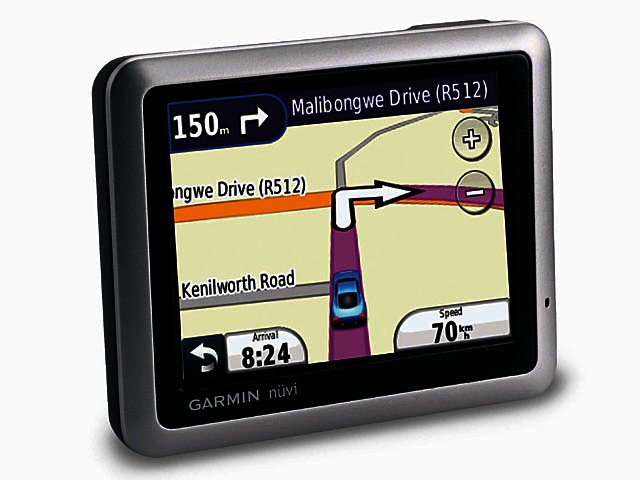The stand-alone GPS market has experienced some real pressure this year with navigation capable smartphones starting to show some promise, especially in the US with the announcement of Google’s free Maps Navigation system. While portable navigation devices still have the advantage of having larger displays, enhanced features and pre-loaded maps, how much longer will consumers be willing to pay the high costs of hardware and map updates?
In an effort to be more competitive GPS companies have introduced entry-level devices with a few higher-end features to push the advantages of standalone devices. Garmin, for instance, have launched the nüvi 1200 which features a 3.5" touch-screen, text-to-speech navigation, an improved pedestrian mode and an overhauled interface.
Pushing the advantage
The biggest advantage of stand-alone GPS devices is that they’re what you call an appliance; i.e. they perform a single, pre-determined function. The nüvi 1200 does its job and it does it well. The device is ready to use almost from the minute you remove it from the box, barring a full battery charge. So there’s no need to configure your internet settings, download navigation software and use your data to view maps, as is the case with your phone’s GPS.
We found that the nüvi 1200 acquired satellites in a hurry, offered detailed local maps full of points of interest, plus contact information for the closet emergency services. Its interface also demands almost nothing of you, with the start-up screen offering two options “Where To?” and “View Map”, which makes it rather easy for you to decide what you would like to do.
Beyond these options you can select your mode of transport (automobile, pedestrian, bicycle), adjust the volume and view the Tools menu. Tools on offer include a useful help function, a picture viewer, a world clock, a currency converter, a calculator and a settings tool which is very straight forward.
The device’s standout feature is its turn-by-turn, text-to-speech navigation. Once you’ve started navigating towards your destination, you never have to look at the display again, since it navigates you via street names as well. We did find that the limited preloaded American voices struggle to pronounce some local street names, such as Malibongwe Drive. You can download custom voices from the web though, but pronunciation is likely to remain a problem.
Look and feel
Beyond loading an entry-level device with tons of features, Garmin has worked hard on the look for the nüvi 1200. Face-on, the device looks rather plain with a grey bezel, but where you really notice Garmin’s design improvements is in the width of the device. At just 1.6 cm thick, the unit is incredibly slim, making it easier to take along when you’re travelling on foot. Despite its slim profile the unit still feels well built and sturdy. It offers a decent 3.5" screen with a native resolution of 320 x 240, with the screen looking sharp and visible even in direct sunlight, but not optimally so.
The packaged wind-screen mount is robust and a little bigger than the entry level mount we’ve seen from TomTom, but works much better.
Issues
The trouble with the nüvi 1200 is that it isn’t priced like the entry-level device of Garmin’s new 1000 series, with a recommended retail price of R2300. With other players like Navigon bringing similarly speced devices to market that are almost R1000 cheaper, Garmin has some thinking to do. Their strong brand position and obvious quality may not be enough.
Why not include more meaningful features on the device, like hands-free calling or an FM transmitter which we’ve seen in higher-end models for a couple of years now? Instead we see the inclusion of an ecoRoute tool on the unit, which supposedly plots the most economic route and displays the amount of fuel you use, based on vehicle profile information you put in. We found this to be a bit of a gimmick. It would have been a lot less gimmicky if it was just integrated with the regular routing options.
Lastly, Garmin’s onscreen keyboard is arranged alphabetically. While this may seem like a non-issue, it is rather annoying for anyone familiar with a QWERTY keyboard. We found inputting destination information to be a pain in the backside using the keyboard.
Conclusion
In the short-medium term standalone devices remain more convenient in South Africa and they will likely always have a place in the market, but the nüvi 1200’s RRP of R2300 will cause many to think twice. The fact that is an excellent device is undisputable. It works extremely well, leveraging many of the advantages available to it as a standalone device. There are less expensive devices offering similar features on the market though, with more likely on the way.
PROS
Turn-by-turn, text-to-speech navigation in an entry-level unit is great.
CONS
The lack of a QWERTY keyboard is just silly and the ecoRoute tool is gimmicky.
USER COMMENTS
Most Read Articles
Read

Magazine Online
TechSmart.co.za is South Africa's leading magazine for tech product reviews, tech news, videos, tech specs and gadgets.
Start reading now >
Download latest issue
Have Your Say
What new tech or developments are you most anticipating this year?
New smartphone announcements (44 votes)
Technological breakthroughs (29 votes)
Launch of new consoles, or notebooks (14 votes)
Innovative Artificial Intelligence solutions (29 votes)
Biotechnology or medical advancements (24 votes)
Better business applications (160 votes)




